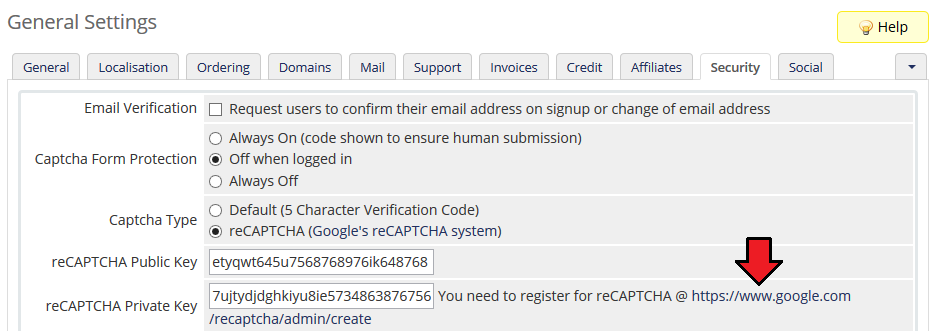Hosting Quota Notifications 1.X For WHMCS
(→Brand Information) |
(→Settings) |
||
| Line 323: | Line 323: | ||
===Settings=== | ===Settings=== | ||
{| | {| | ||
| − | |style="padding: 10px 0px 20px 15px;"|In this window you will be able to configure all the most important settings of your brand | + | |style="padding: 10px 0px 20px 15px;"|In this window you will be able to configure all the most important settings of your brand including billing, payment gateways, SMTP and email templates configuration. |
|} | |} | ||
====General==== | ====General==== | ||
{| | {| | ||
| − | |style="padding: 10px 0px 15px 15px;"|In general settings you will configure the main brand options. <br/> | + | |style="padding: 10px 0px 15px 15px;"|In the general settings you will configure the main brand options. <br/> |
| − | First fill out brand's '' 'Email Address', 'Company Name' '' and '' 'TOS URL' ''. Next choose brand's '' 'Color', 'Ticket Departments' , 'Default Language', 'Template' '' and '' 'Order Template' ''.<br /> | + | First, fill out the brand's '' 'Email Address', 'Company Name' '' and '' 'TOS URL' ''. Next, choose the brand's '' 'Color', 'Ticket Departments' , 'Default Language', 'Template' '' and '' 'Order Template' ''.<br /> |
| − | + | Make sure that the chosen template is integrated with Multibrand correctly (see the [https://www.docs.modulesgarden.com/Multibrand_For_WHMCS#Integration_Code Integration Code] section). Finally, toggle '' 'Auto Client Assign' '' if you wish to. <br/> | |
| − | Here you can also manage brand | + | Here you can also manage your current brand's status, but you should change it to '' 'Enabled' '' only after you have configured the rest of the settings. <br/> |
| − | Do not forget to '' 'Save Configuration' ''. | + | Do not forget to press '' 'Save Configuration' ''. |
<br/><br/> | <br/><br/> | ||
| − | '' '''Note:''' Currently new users | + | '' '''Note:''' Currently all new users added by admin or through API will not be assigned to any brand by default. This feature will be included in the next releases.'' |
<!-- | <!-- | ||
| − | '' '''Note:''' Only published brands can be set as default. New users | + | '' '''Note:''' Only published brands can be set as default. New users added by admin or through API will be assigned to the default brand.'' |
--> | --> | ||
|} | |} | ||
Revision as of 10:35, 20 September 2017
Contents
|
About Multibrand For WHMCS
| Multibrand For WHMCS To Do To Do To Do To Do To Do To Do To Do To Do To Do To Do To Do To Do To Do To Do To Do To Do
To Do To Do To Do To Do To Do To Do To Do To Do To Do To Do To Do To Do To Do To Do To Do To Do To Do To Do To Do To Do To Do To Do To Do To Do To Do To Do To Do To Do To Do To Do To Do To Do To Do To Do To Do To Do To Do To Do To Do To Do To Do To Do To Do To Do To Do To Do To Do To Do To Do To Do To Do To Do To Do To Do To Do To Do To Do To Do To Do To Do To Do To Do To Do To Do To Do To Do To Do To Do To Do To Do To Do To Do To Do To Do To Do To Do To Do To Do To Do To Do |
- Addon Features:
| ✔ User-Friendly Management Of Multiple Brands |
| ✔ Easy Modification Of Existing Brands |
| ✔ Assign Ticket Departments To Brands |
| ✔ Configure Payment Gateways For Each Brand |
| ✔ Configure Email Templates For Each Brand |
| ✔ Configure SMTP Mailboxes For Each Brand |
| ✔ Set Up Products, Addons And Domain Pricing For Each Brand |
| ✔ Display And Migrate Clients Between Brands |
| ✔ Display And Manage Relations Of Services, Invoices, Tickets, Knowledgebase, Downloads And Announcements Assigned To Brands |
| ✔ Toggle Invoice Branding |
| ✔ Toggle Brand Status On Click |
| ✔ Toggle Auto Client Assign |
| ✔ Monthly And Total Sale Amount Per Brand |
| ✔ View Dynamic Statistics On Each Brand |
| ✔ View Logs |
- Admin Area Features:
| ✔ Order Branded Products |
| ✔ Create Branded Invoices |
- Client Area Features:
| ✔ Display Client Area Template And Default Language Depending On Brand |
| ✔ Access Services, Invoices, Downloads, Ticket Departments and Payment Gateways Assigned To Brand |
| ✔ View Knowledgebase Articles And Announcements Assigned To Brand |
| ✔ Receive Branded Emails And Invoices |
| ✔ Clients Registering Into A Brand May Be Automatically Assigned To It |
| ✔ Clients Logging Into Another Brand May Be Automatically Assigned To It With The Same Access Details |
- Brand Configuration:
| ✔ Set Up Brand Name |
| ✔ Brand Company Name |
| ✔ Brand Domain Address |
| ✔ Brand Logo |
| ✔ Brand Default Language |
| ✔ Brand Template |
| ✔ Brand Order Template |
| ✔ Brand Address |
| ✔ Brand Signature |
| ✔ Brand Email Address |
| ✔ Brand Ticket Departments |
| ✔ Brand Graph Color |
| ✔ Brand Terms Of Service URL |
| ✔ Brand Invoice Sequential Number, Format And Pay To Text |
| ✔ Set Up Branded Or Normal Payment Gateways |
| ✔ Brand Email CSS Styling And Content |
| ✔ Brand Email Templates In Various Languages |
- Branded Payment Gateways:
| ✔ 2Checkout |
| ✔ Authorize.Net |
| ✔ Authorize.Net CIM |
| ✔ Checkout.com |
| ✔ PayPal REST |
| ✔ Stripe |
- General Info:
| ✔ Multi-Language Support |
| ✔ Supports PHP 5.4 Up To PHP 7 |
| ✔ Supports WHMCS Template Six |
| ✔ Supports WHMCS V7 |
Installation
| This tutorial will show you how to successfully install and configure Multibrand For WHMCS. We will guide you step by step through the whole installation and configuration process. |
Installation
| 1. Log in to your client area and download the module. |
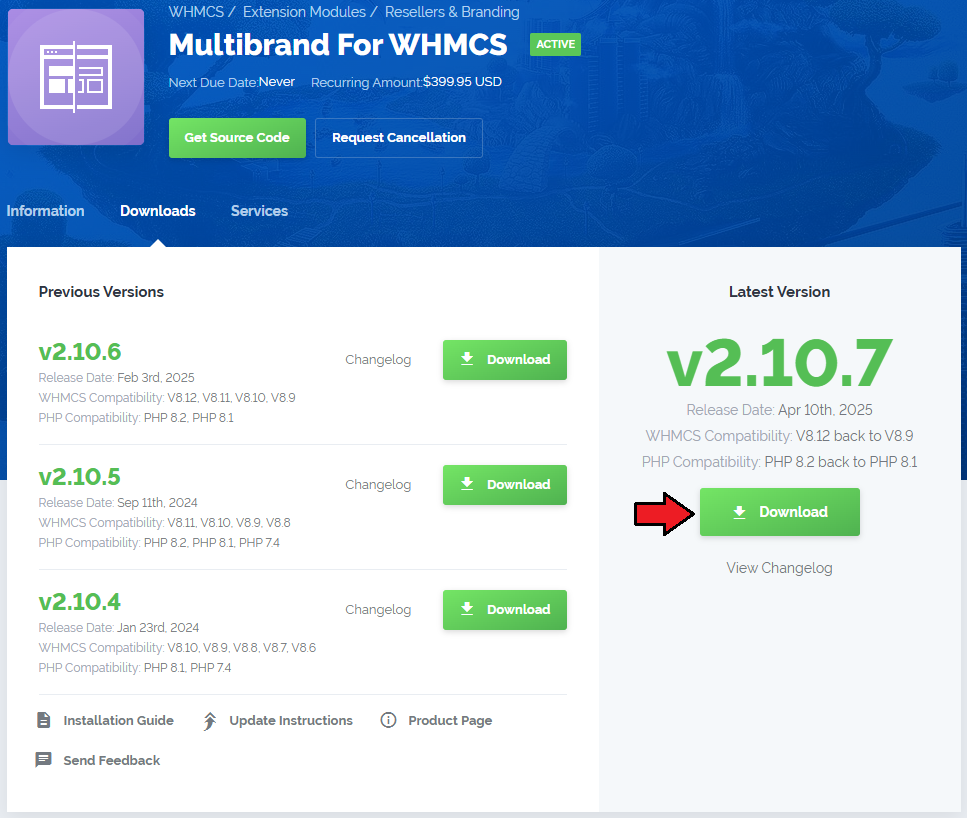
|
| 2. In the downloaded file you will find two packages that support different PHP versions. As presented on the screen below, the first one is dedicated to PHP 7, while the second one is aimed at PHP 5.4 up to PHP 5.6. It does not apply to open source versions. Note: You can check current PHP version in your WHMCS. To do so proceed to 'Utilities' → 'System' → 'PHP Info'. |

|
| 3. Extract the downloaded file and choose the one with the right PHP version. Upload and extract the PHP file into the main WHMCS directory. The content of PHP version files should look like this. |

|
| 4. When you install Multibrand For WHMCS for the first time you have to rename 'license_RENAME.php' file. File is located in 'modules/addons/MultibrandFunctionality/license_RENAME.php'. Rename it from 'license_RENAME.php' to 'license.php'. |
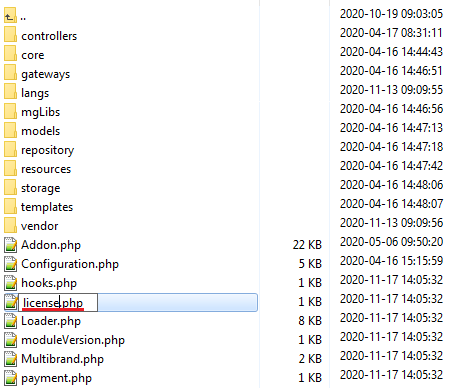
|
| 5. In order to configure your license key, you have to edit the previously renamed 'license.php' file. Enter your license key between quotation marks as presented on the following screen. You can find your license key in your client area → 'My Products'. |

|
Activating Addon Module
| 6. Now you have to activate the module in your WHMCS system. Log in to your WHMCS admin area. Go to 'Setup' → 'Addon Modules'. Afterwards, find 'Multibrand' and press 'Activate' button. |
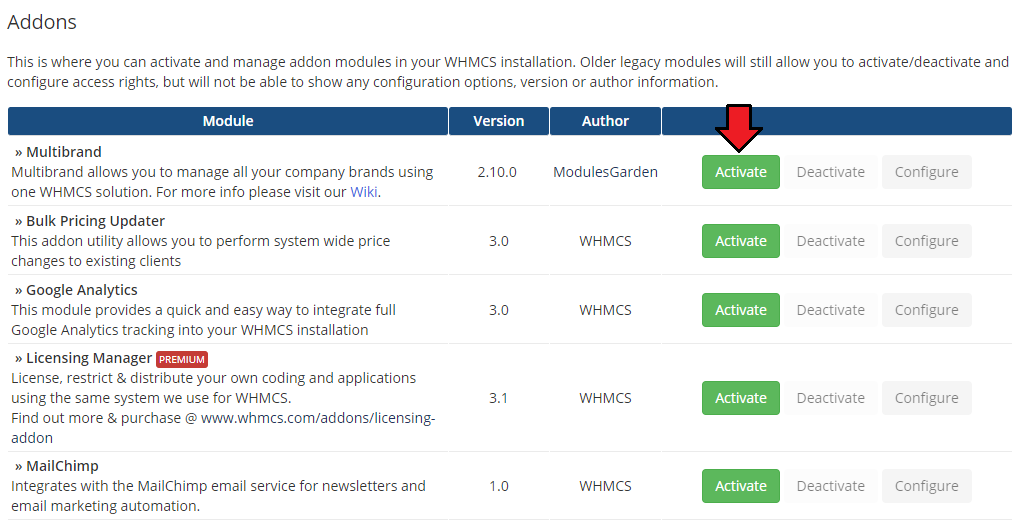
|
| 7. In the next step you need to enable the hooks and grant access to this module. To do so, click on 'Configure' button, go to 'Access Control' area and check the required group of administrators. Press 'Save Changes'. |
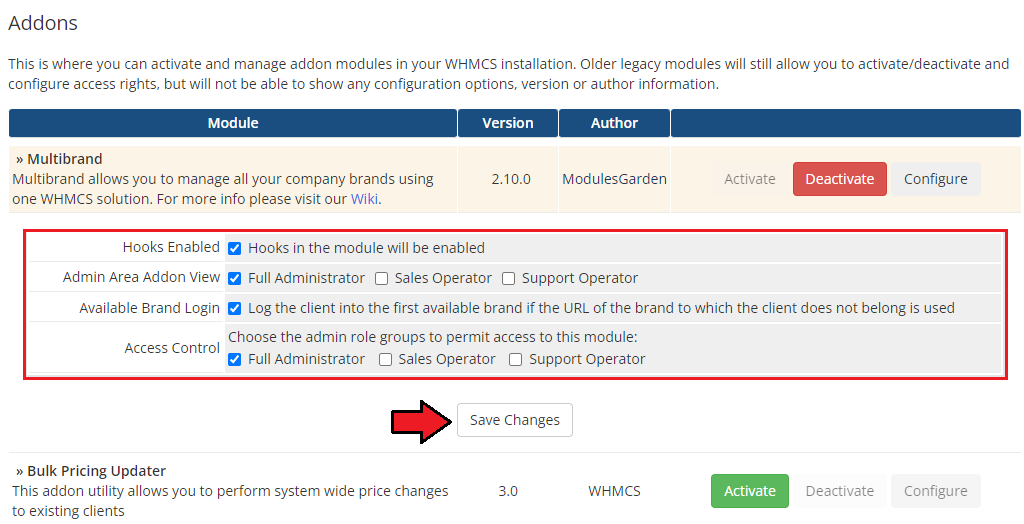
|
Additional Settings
| 8. Now, set up the 'storage' folder with its subfolders as recursively writable. This folder are located in 'your_whmcs/modules/addons/Multibrand/' location. |
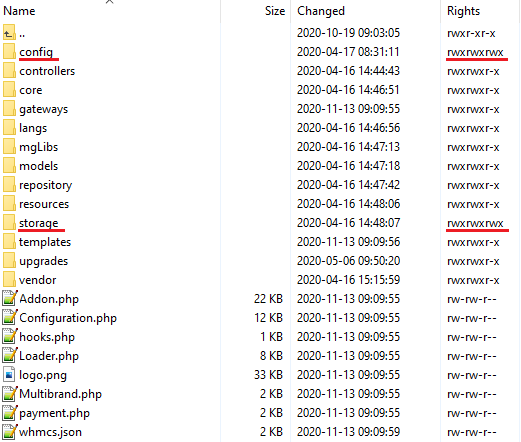
|
| 9. You will also need to set up 'gateways' and 'callback' folders as writable. The 'gateways' folder is located in 'your_whmcs/modules/' and the 'callback' folder in 'your_whmcs/modules/gateways' (do NOT mistake the folders with those in the Multibrand addon location) |
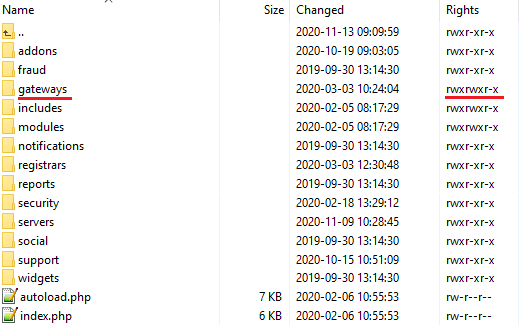
|
| 10. The next step is replacing 'invoicepdf.tpl' file with 'invoicepdf_rename.tpl' for each of the templates used. The 'invoicepdf_rename.tpl' file is located in the 'your_whmcs/templates/six/' folder. |
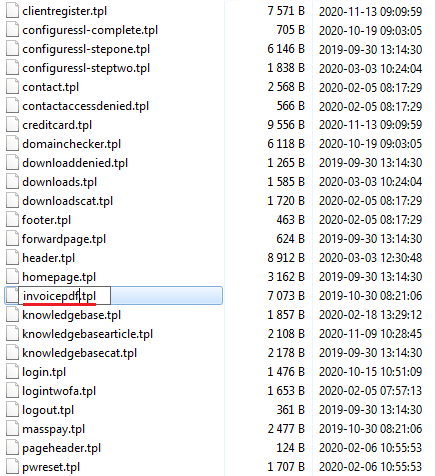
|
Integration Code
| 11. Now you can access your Multibrand For WHMCS module. Simply go to 'Addons' → 'Multibrand'. But, before you can start using the module, you still need to set up the 'Integration Code'. It is required for the correct logo branding and it should be done for all brand templates that you want to use. |
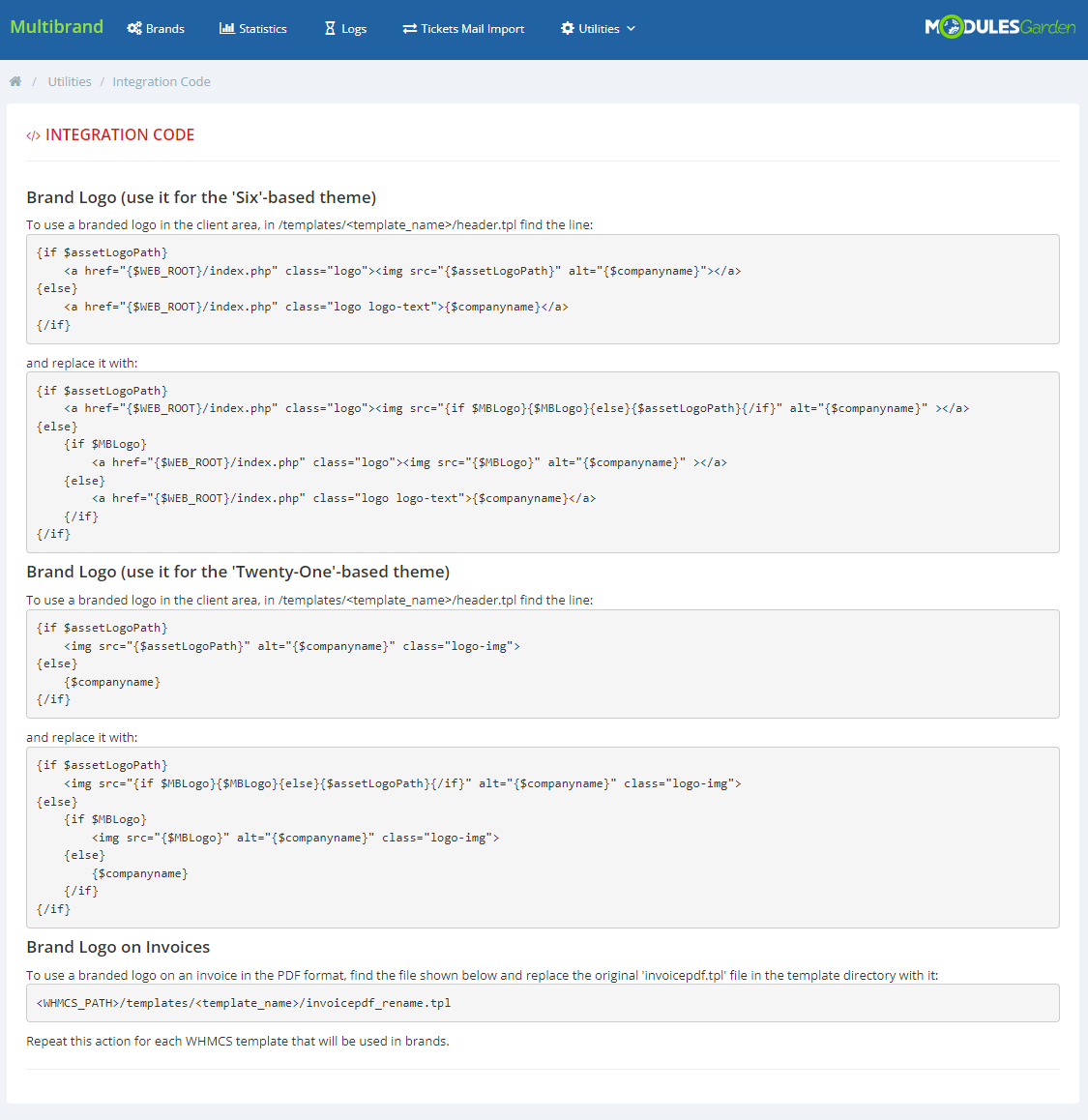
|
| 12. And that is all! You have now completed the installation of the module. |
Migration
| In the current beta 2.0.0 version it is not possible to easily migrate data from 1.8.X to the 2.X module version. Such a migration functionality will be added in the future stable version. We are sorry for the inconvenience. |
Configuration and Management
| In this section we will show you how to properly set up and use Multibrand For WHMCS. |
Brands
| In the 'Brands' tab you can create and manage your brands using a single instance of WHMCS solution. Important: Due to the module beta limitations, configuration of one of the brands must be manually set to your main WHMCS domain. Simplification of this process will be solved in the future editions. |
New Brand
| Let us start by creating a new brand. For that purpose go to the 'Brands' tab and press 'Add a new brand' |
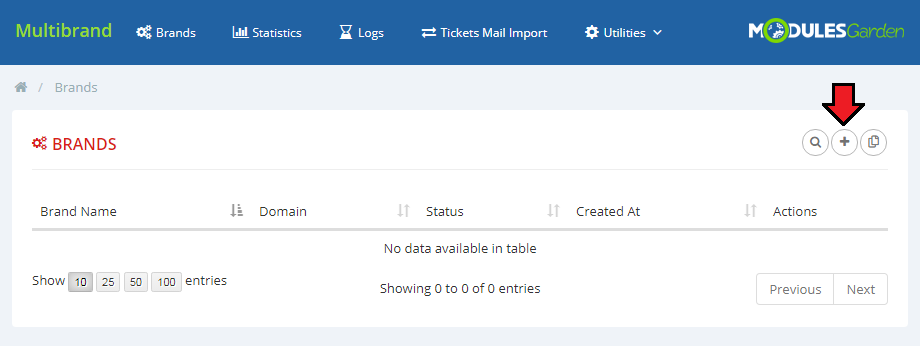
|
| Fill in the brands's 'Name' and 'Domain' with desired values and press 'Save' button. |
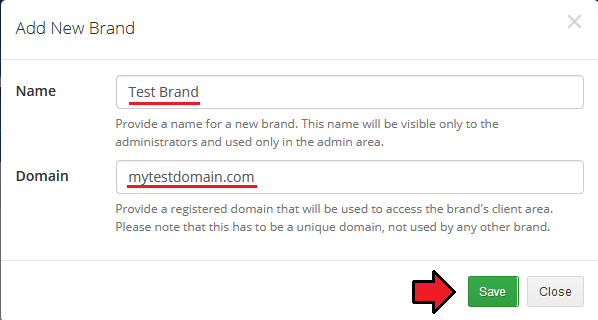
|
| Your first brand is created. Next, press 'Edit' ' |
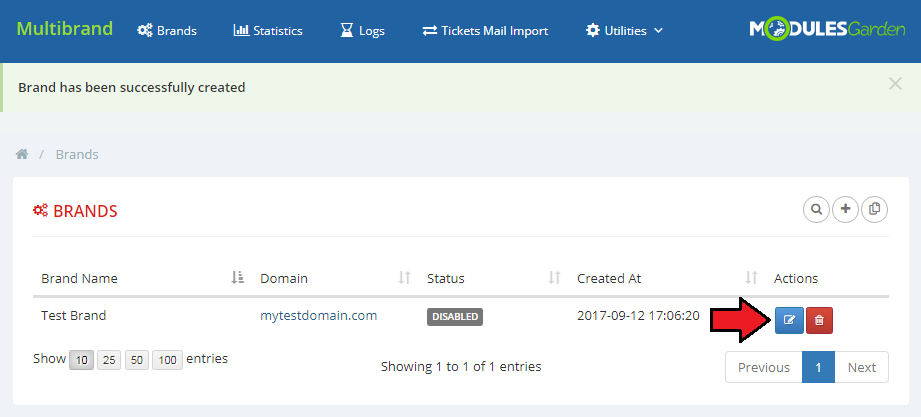
|
| You will be moved to the brand configuration area, where you can manage your brand's information and settings. |
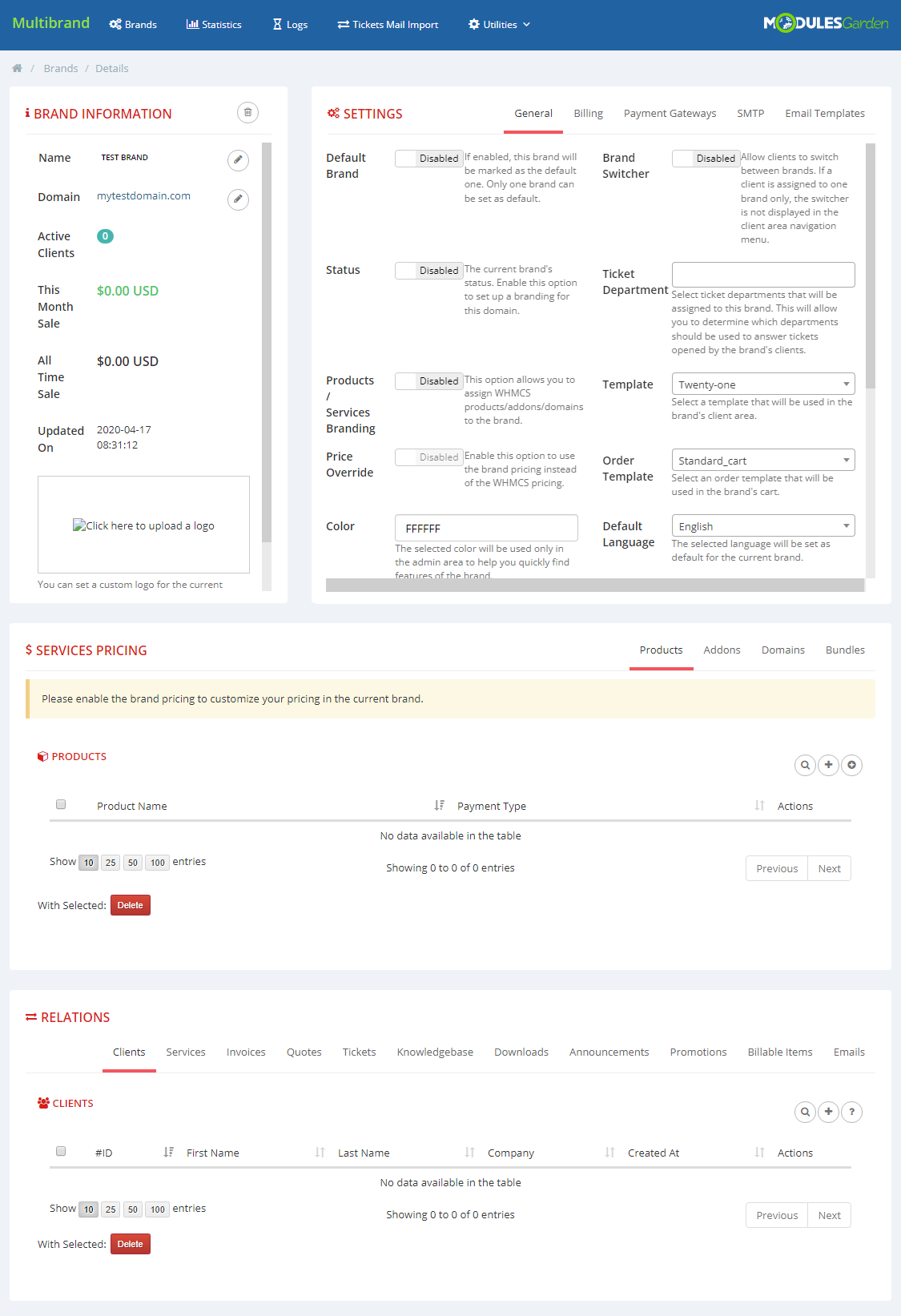
|
|
Note: Once the configuration of your brand is complete, you will still need to set up a CNAME DNS record before the brand is published (status - enabled). |
Brand Information
| In the Brand Information window you can edit the brand name, domain name and custom logo. In addition, you can see the current month's revenue, total sales and the last brand update. |
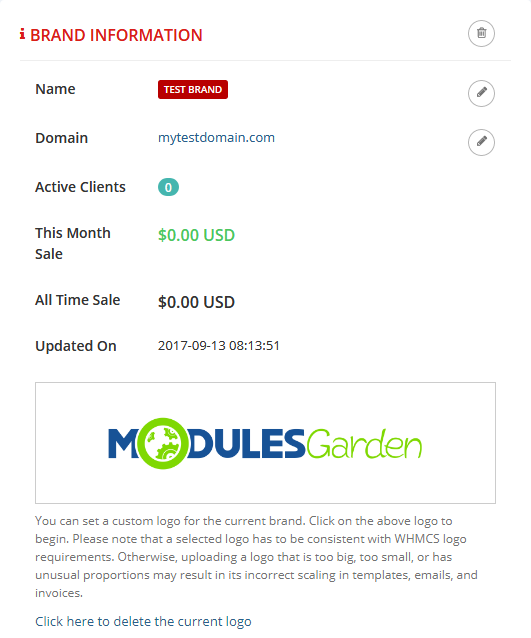
|
Settings
| In this window you will be able to configure all the most important settings of your brand including billing, payment gateways, SMTP and email templates configuration. |
General
| In the general settings you will configure the main brand options. First, fill out the brand's 'Email Address', 'Company Name' and 'TOS URL' . Next, choose the brand's 'Color', 'Ticket Departments' , 'Default Language', 'Template' and 'Order Template' . |
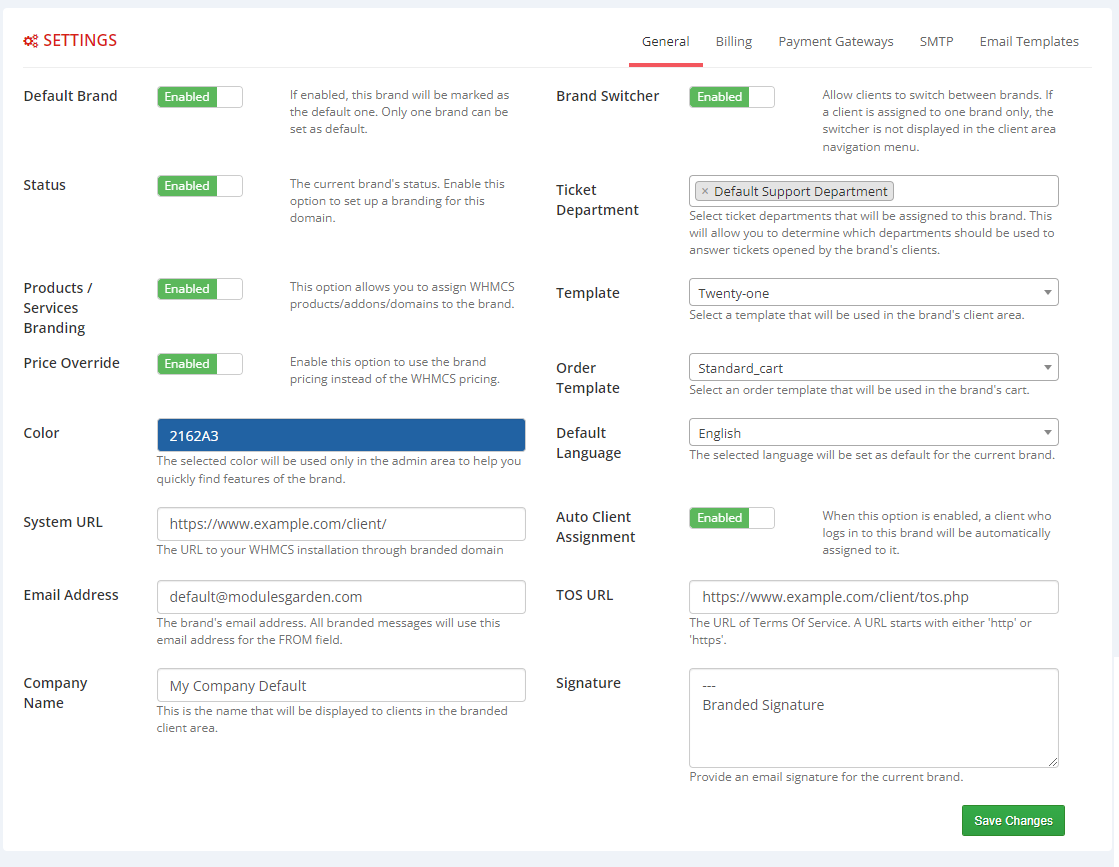
|
In billing settings you can configure the appearance of your invoices.
Note: Remember to do the 'Additional Settings' step during module installation to make the PDF invoices also branded. |
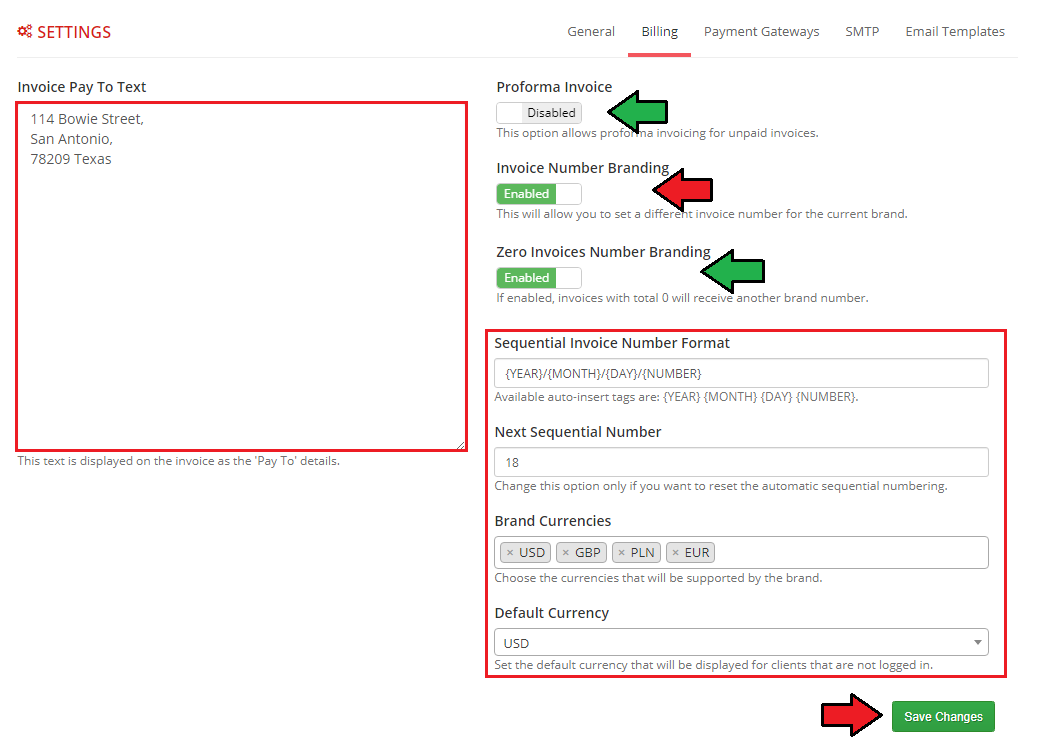
|
Payment Gateways
| This tab allows you to configure payment gateway for the brand which will work independently of that configured in WHMCS. You can check the list of currently available gates in the Feature List. |

|
| Next choose the desired gate from the list and press 'Confirm' button. |
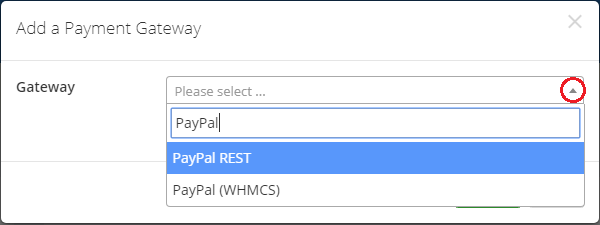
|
| Finally fill the payment gateway settings, according to the details received from the provider. Save the configuration and activate the gateway. |
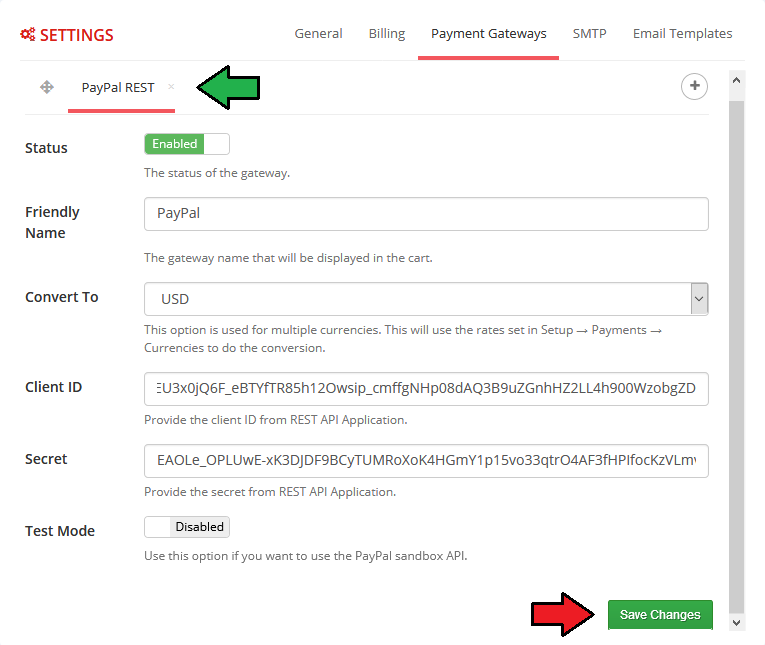
|
| Note: You may still use any other payment gateway that is active in your WHMCS system. These gates will have a (WHMCS) label. Multibrand For WHMCS can work with any gateway that works within your WHMCS, the only limitation is that the other payment gateways use the same settings for all brands. |
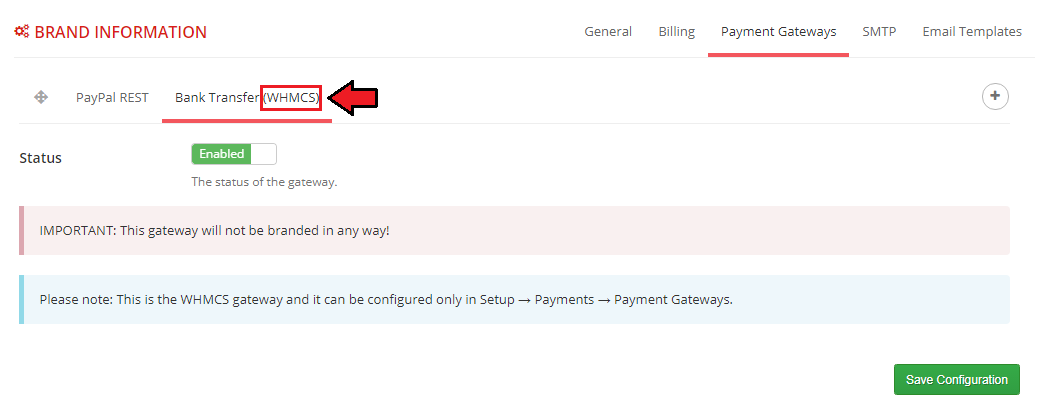
|
SMTP
| If you would like to use for this brand a different outgoing mail configuration than the main WHMCS settings, you can do so in this tab. In addition you can set custom CSS email styling and header and footer content. |
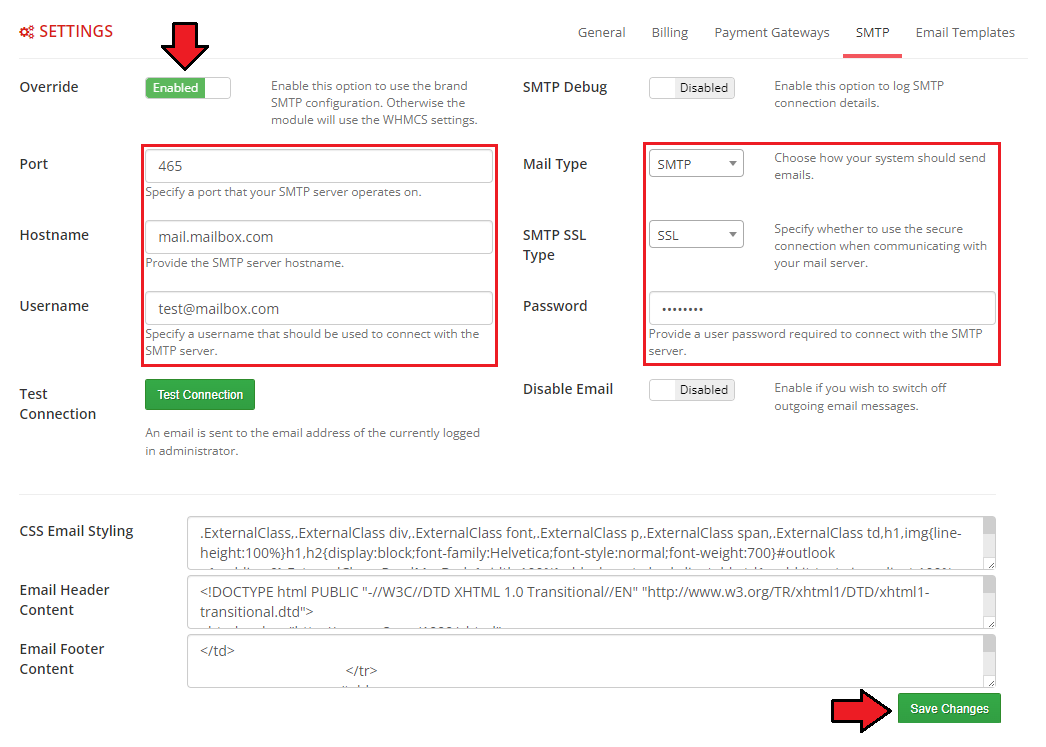
|
Email Templates
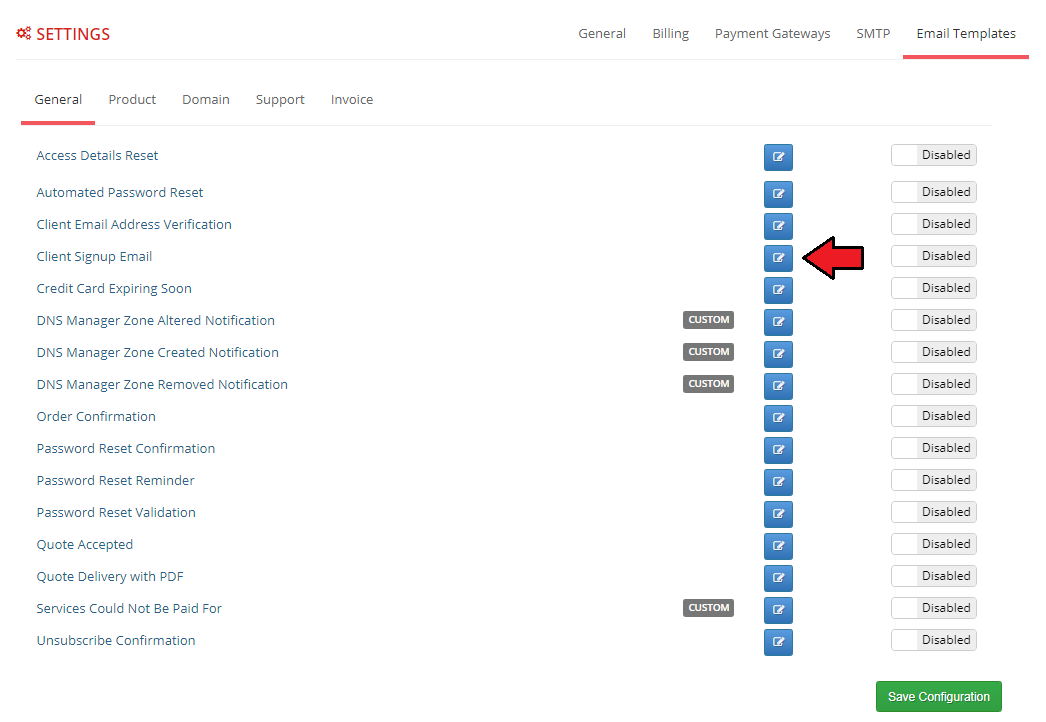
|
| Next, enter the desired subject and message content. You can also add them in several languages. In addition, you can also use the available merge fields tags just like in standard email templates. Save the changes after finishing. |
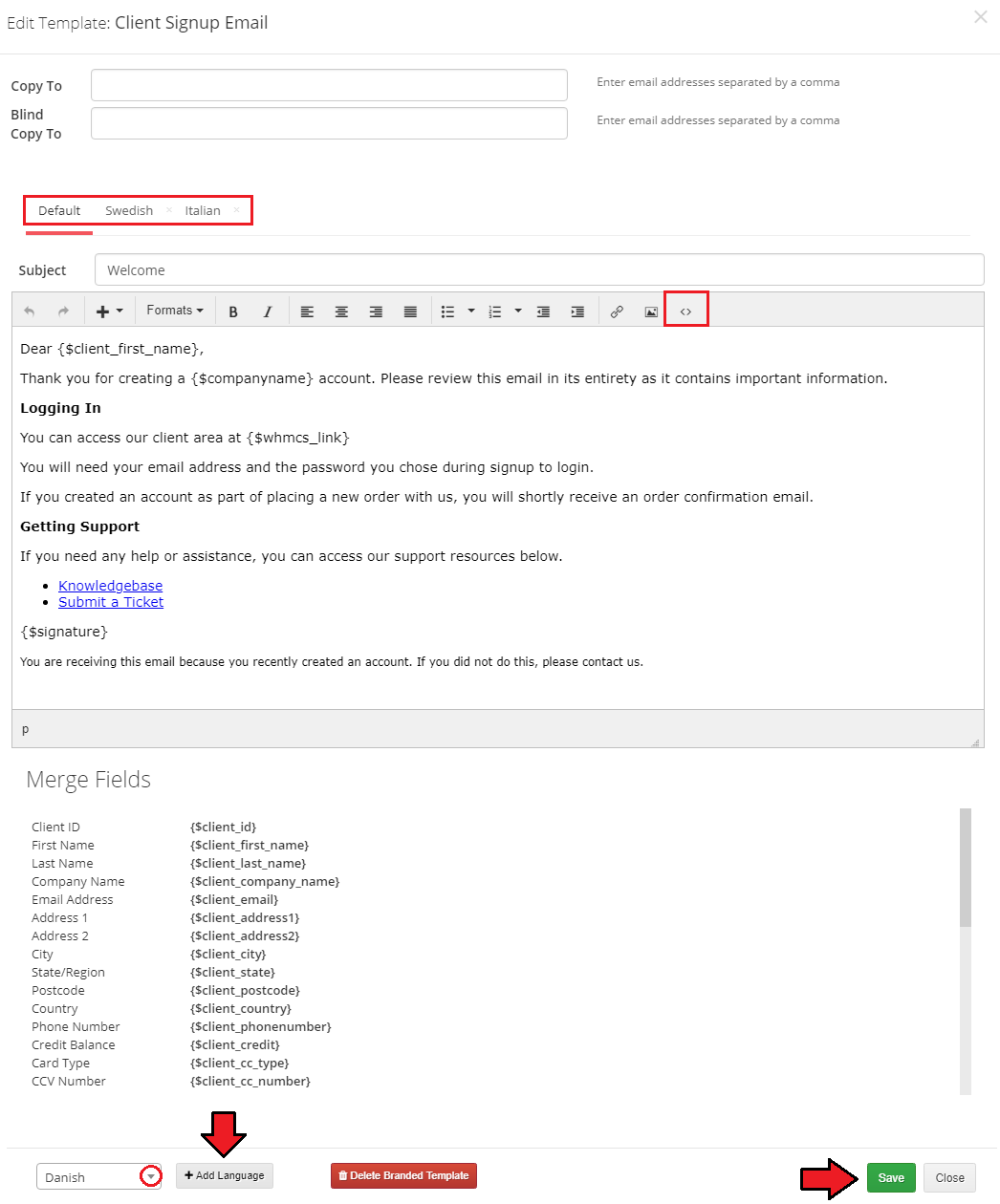
|
| Finally toggle edited template to enabled and save configuration. Next to the edited template you will see the 'Branded' label. If you would like to restore the default template, simply return to editing it and click the 'Delete Template' button. |
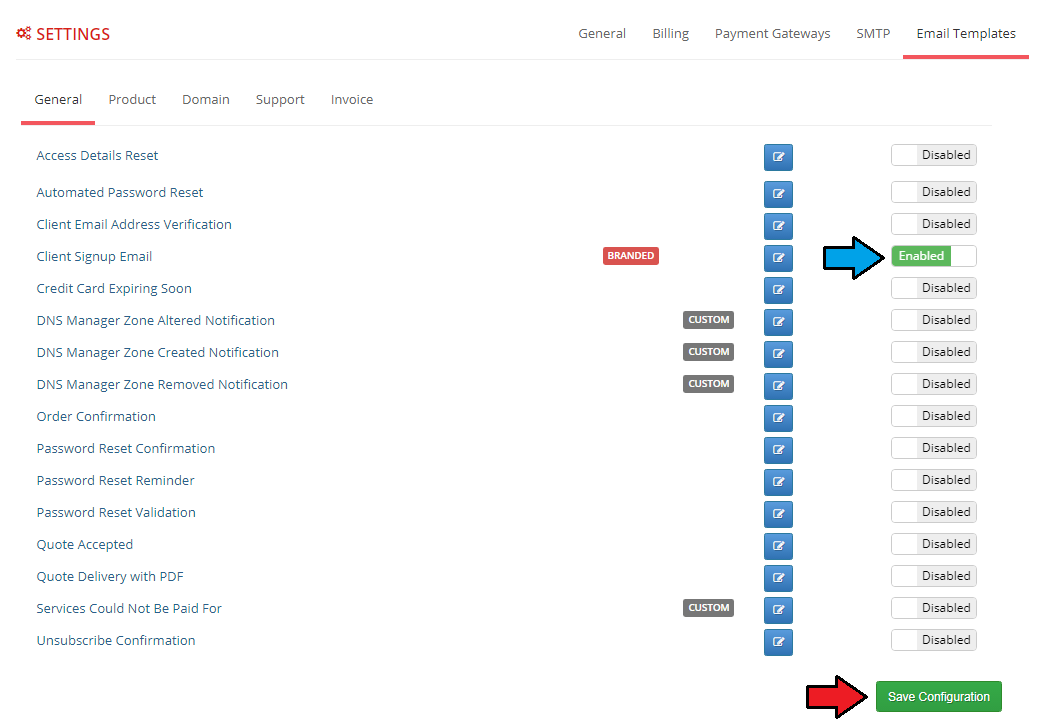
|
Services Pricing

|
| Select the product for which you want to set branded prices and click 'Save' . |
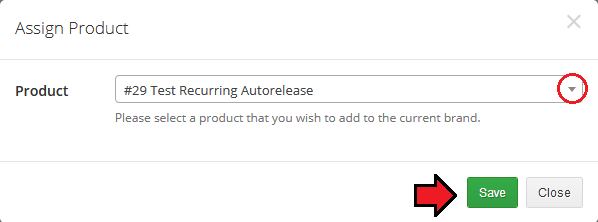
|
| Next open the pricing editor for the chosen product. |

|
| Here you can configure the desired prices in selected billing cycles and currencies. You can also automatically fill in amounts from the main product and update them refreshing the currencies rate. Note: Availability of billing cycles, prices and currencies to be edited depends on their main configuration in WHMCS. |
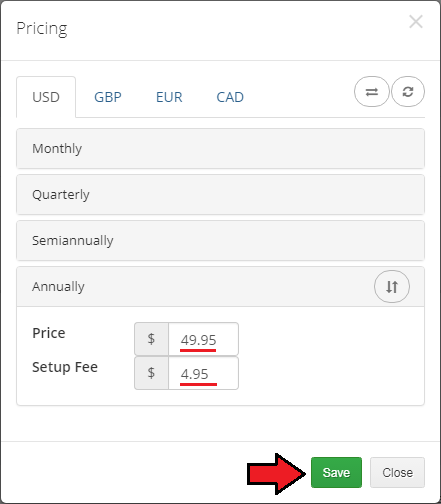
|
| From now on, the pricing for this product will be branded. In the same way, you can also configure pricing for the addons and domains. |
Relations
| In the relations section you can see which Clients, Services, Invoices, Knowledgebase, Downloads and Announcements are assigned to this brand. In addition, you can manually manage, assign and unassign selected items to brand. Note: Currently there is no possibility of mass management, assigning and unassigning selected items to the brand. This functionality will be implemented in future releases. |
Clients
| In the clients tab you can see customers who are assigned to the brand and the date on which they were assigned. Assignment takes place at the moment of client registration from the branded domain. You can also manually assign already existing customer to the brand or migrate to another. Note: If 'Auto Client Assign' option is enabled then the customers who are already registered in one of the brands and try to log in to another brand, their will also be automatically assigned to it. |
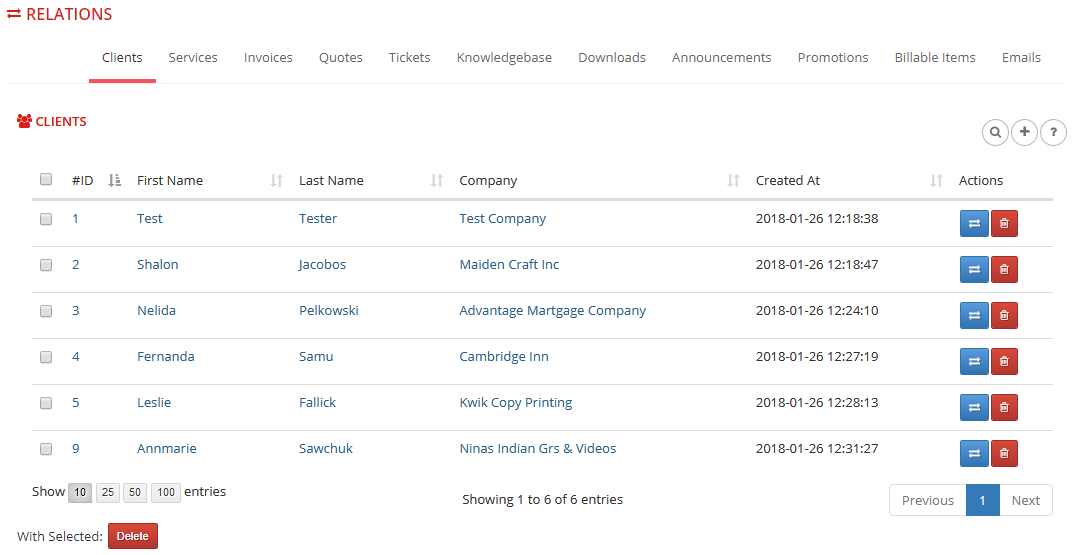
|
| To assign an exiting client to the brand, press 'Add' In the open pop-up select the customer you want to add to the brand and press 'Save' . |
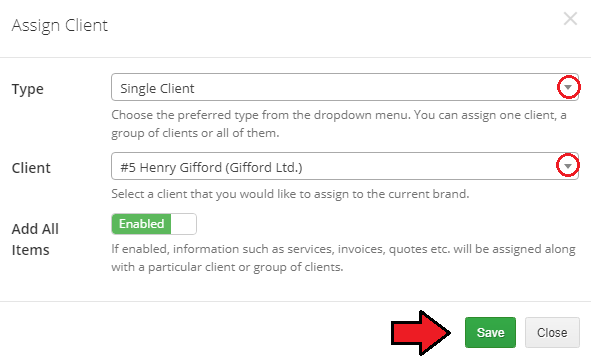
|
| You can also migrate the customer from this brand to another one. Click 'Migrate' |
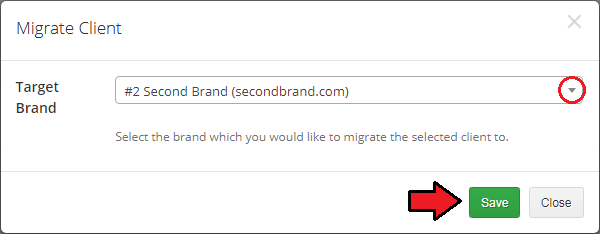
|
| And finally, if you want to delete the customer relationship with this brand, press the 'Delete' |
Services
| In the Services tab you can see which Products, Addons and Domains have a relation with this brand. These services are automatically added to the brand while ordering from the branded domain. |
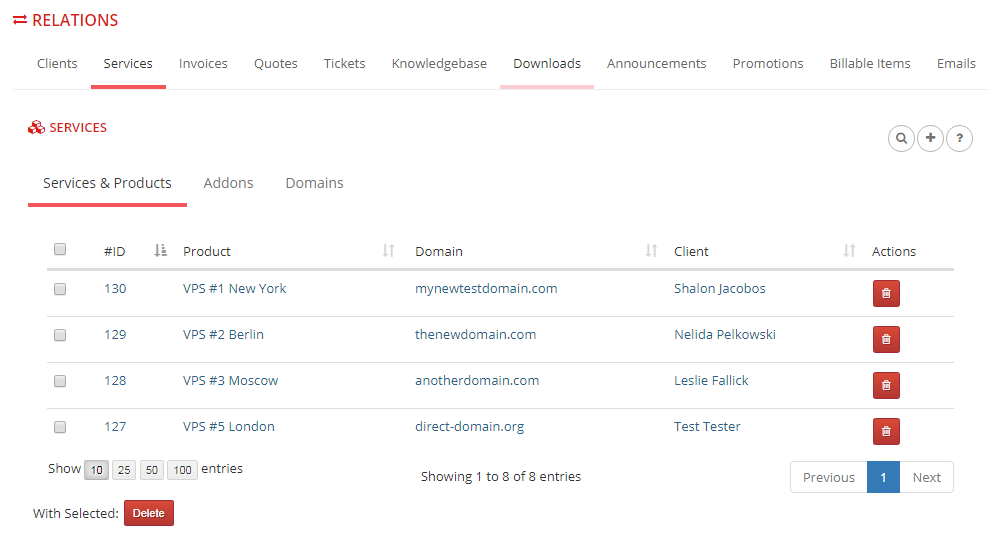
|
| You can also manually add a relation for a service that is not yet branded. Press 'Add' |
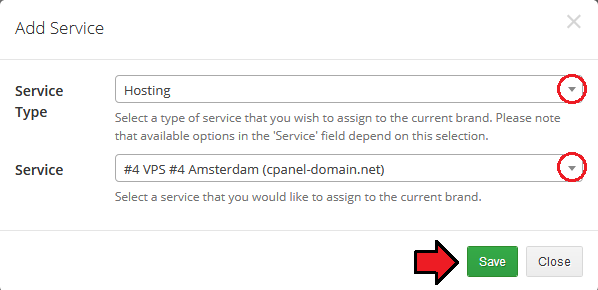
|
| And if you want to delete a service relation with the brand, press 'Delete' |
Invoices
| In this tab you can see which invoices have a relation with brand. These invoices are automatically added to the brand after the order has been created from branded domain. |
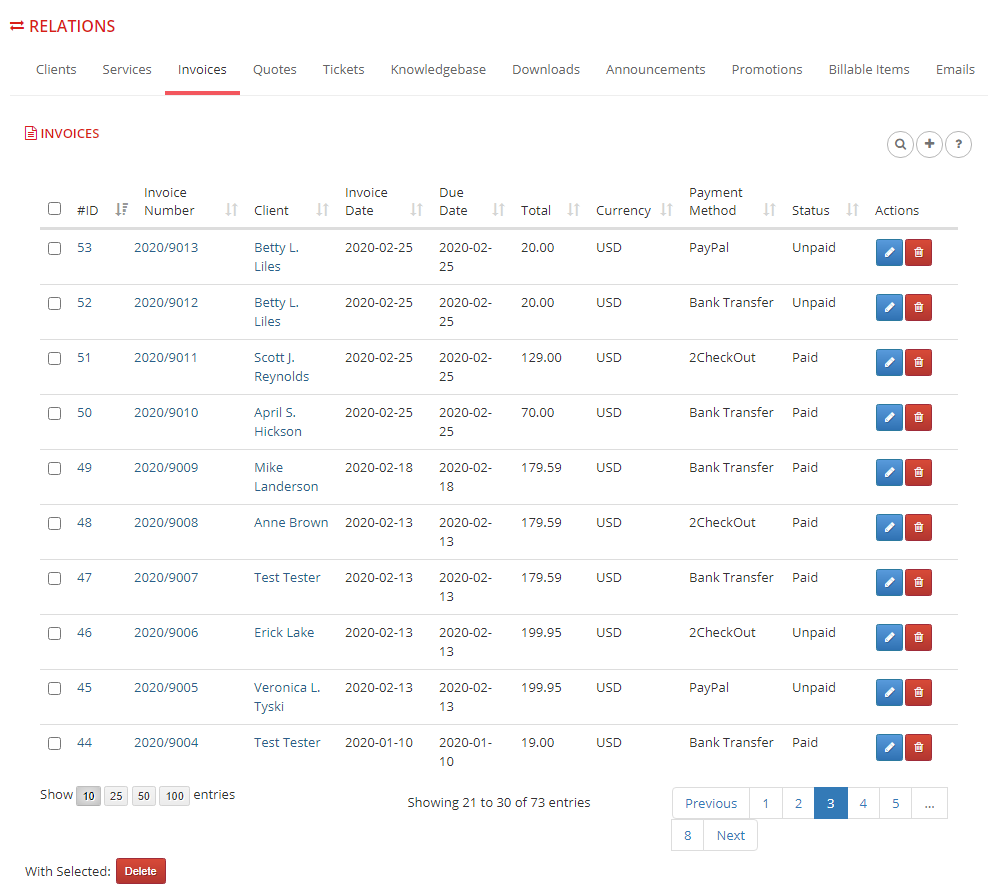
|
| You can also manually add a relation for the invoice that is not yet branded. Press 'Add' |
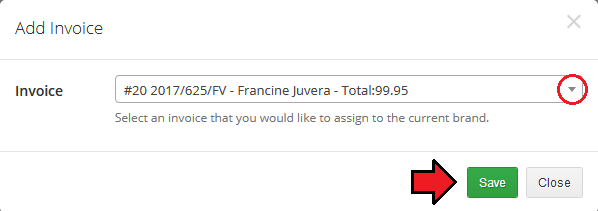
|
| And if you want to delete an invoice relation with the brand, press 'Delete' |
Tickets
| In this tab you can see which tickets have a relation with brand. These tickets are automatically branded after ticket has been opened in one of earlier branded departments. |
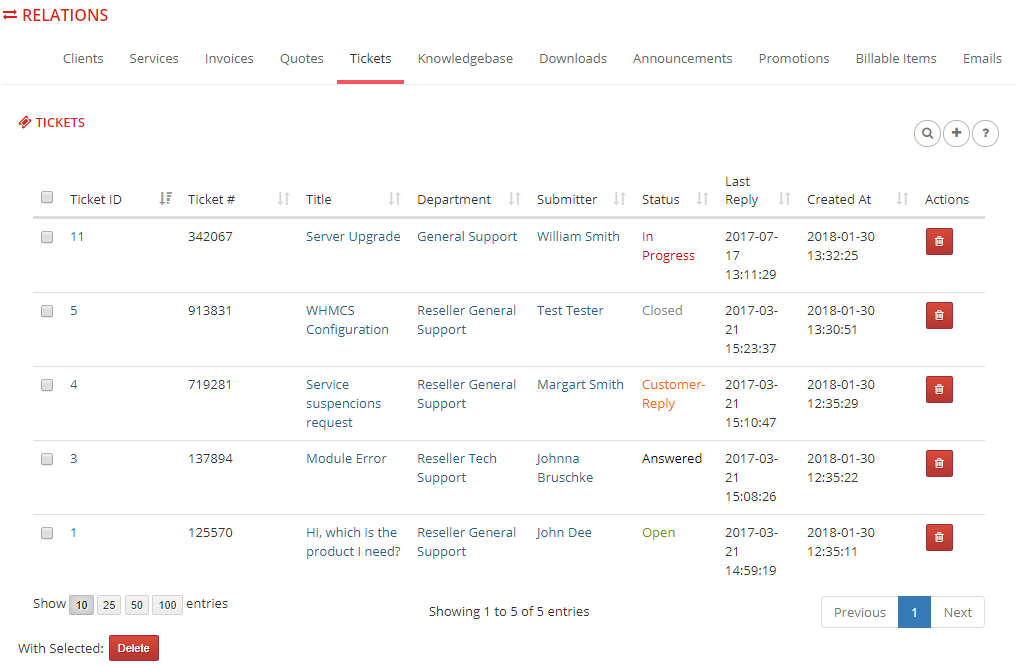
|
| You can also manually add a relation for the ticket that is not yet branded. Press 'Add' |
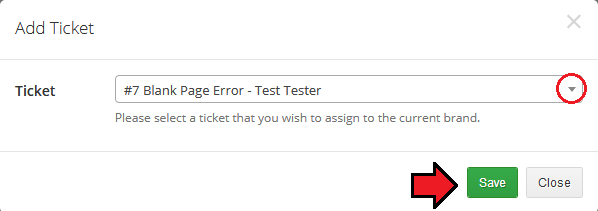
|
| And if you want to delete a ticket relation with the brand, press 'Delete' |
Knowledgebase
| In this tab you can see which your knowledgebase articles have a relation with brand. In addition, you can find here statistics of views, useful points, number of votes and date of assignment to the brand. |
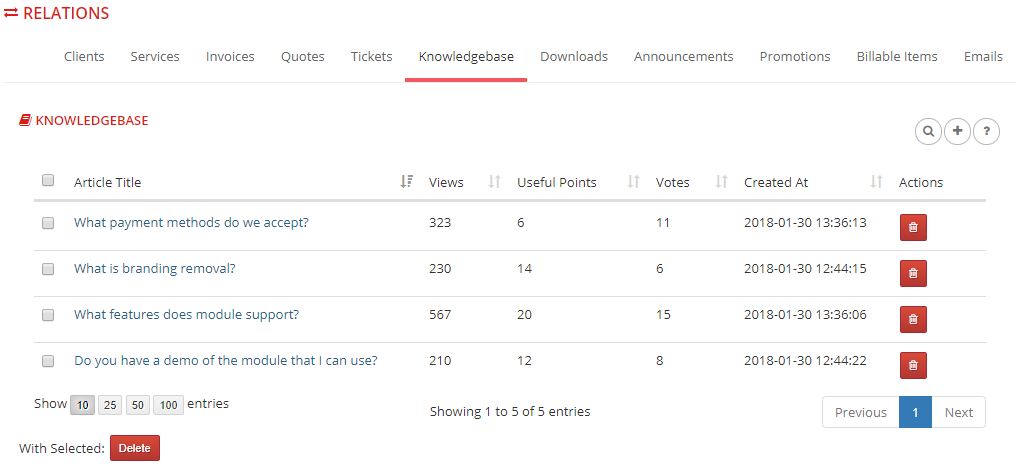
|
| To add a relation for the knowledgebase articles press 'Add' |
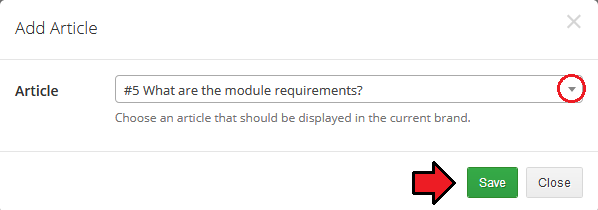
|
| And if you want to delete a knowledgebase article relation with the brand, press 'Delete' |
Downloads
| In this tab you can see which of your files available for download have a relation with brand. In addition, you can find here download category, type, number of downloads and date of assignment to the brand. |
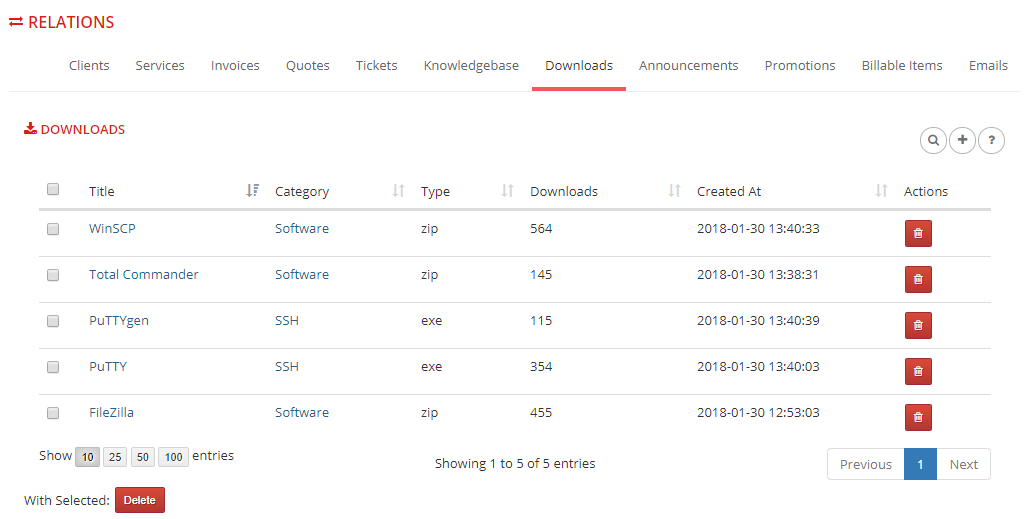
|
| To add a relation for the download press 'Add' |
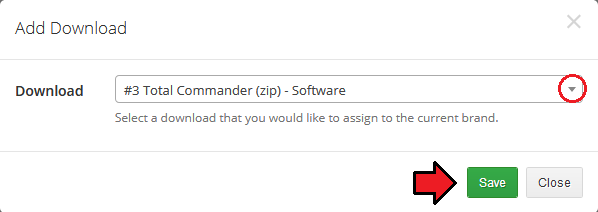
|
| And if you want to delete a download relation with the brand, press 'Delete' |
Announcements
| In this tab you can see which of your announcements have a relation with brand. In addition, you can find here date of announcement creation, assignment to the brand and published status. |
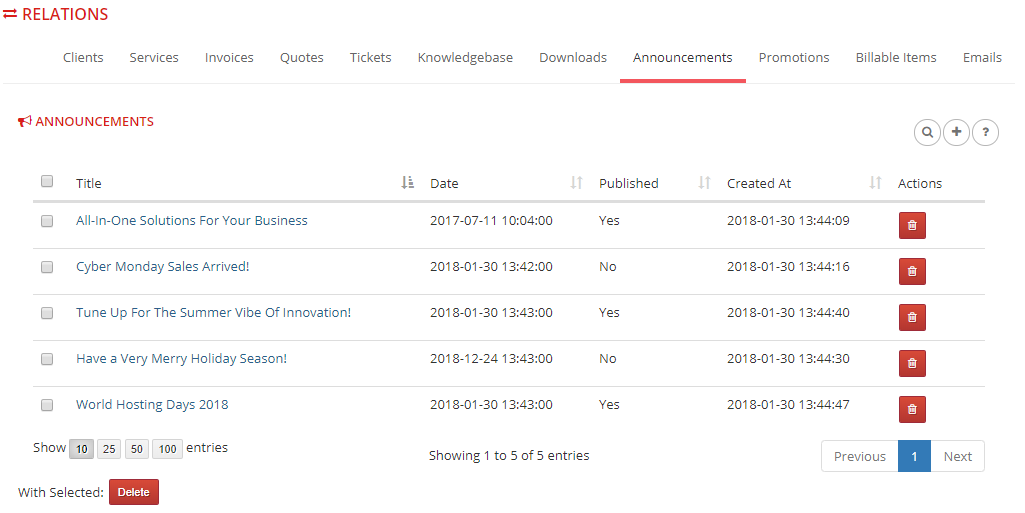
|
| To add a relation for the announcement press 'Add' |
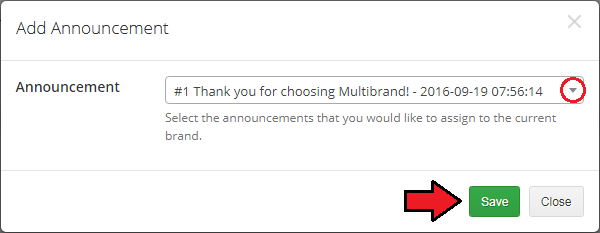
|
| And if you want to delete a announcement relation with the brand, press 'Delete' |
Statistics
| In the statistics section you will find sales charts of selected brands. You can filter them by date period and selected brands. |
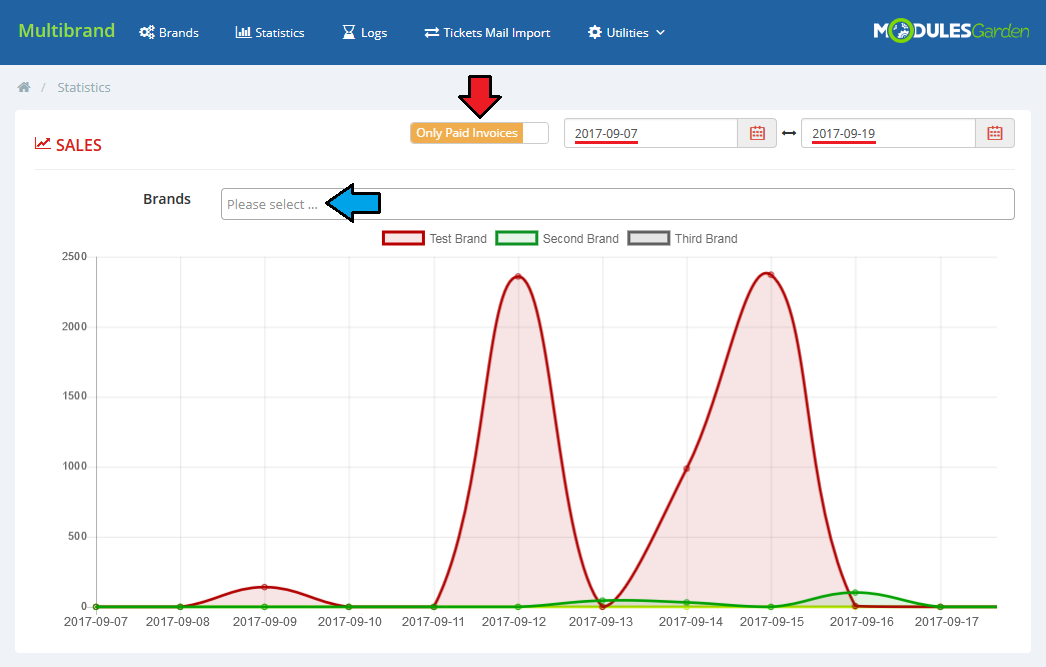
|
Logs
| Logs sections allows you to view warnings and errors related to your brands. |
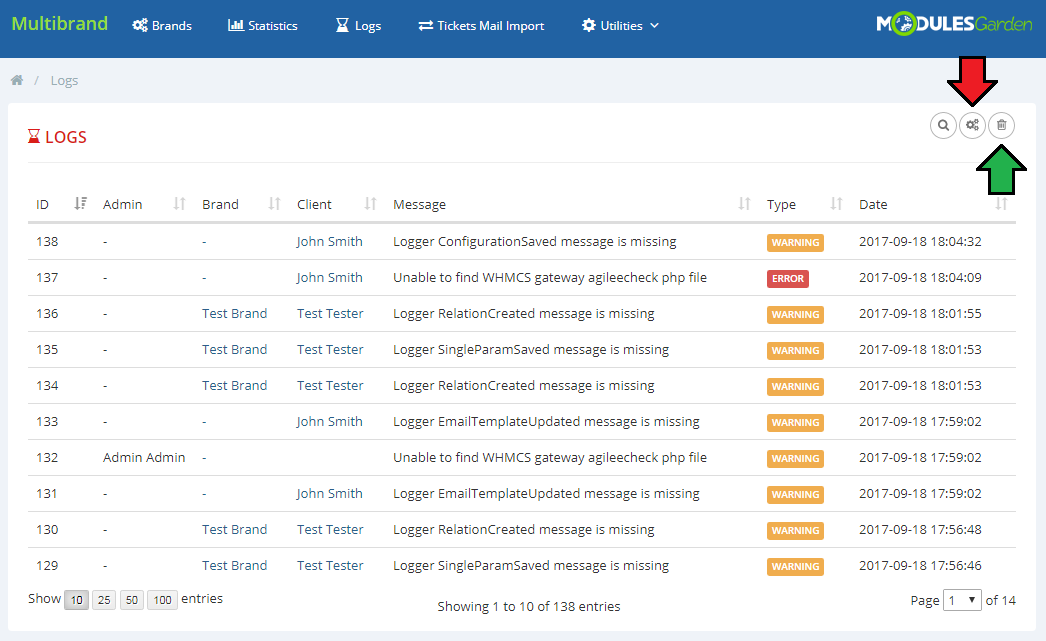
|
Branded Admin Area Functionalities
| Due to the beta version, not all sections available in the previous module versions provide the direct actions with the brand relations yet. See the Branding Limitations section for more information. More admin area integrations are coming coon. |
Order Creation
| If the administrator wants to create an order for a client manually, their can directly create a relation to the selected brand (provided that the client belongs to it). Additionally, their can also assign a payment gateway available in a given brand. |
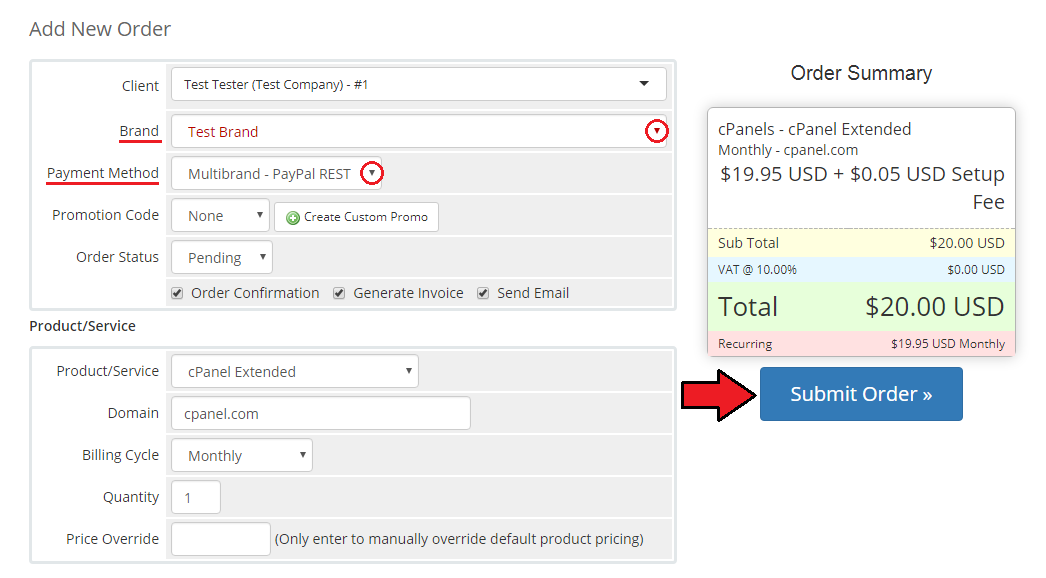
|
Invoices
| If the administrator creates a new invoice for the customer, he has the possibility to select a direct relationship with the given brand. |
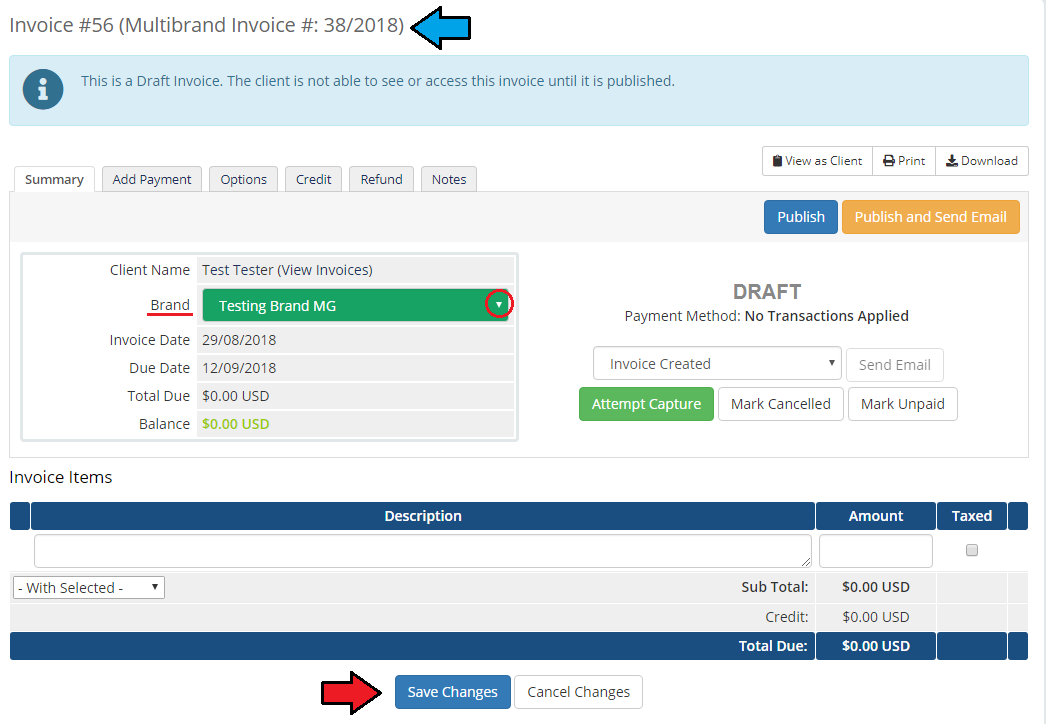
|
| Additionally, for previously created invoices there is also a possibility of direct changing the brand relation. |

|
Branded Client Area
| Multibrand For WHMCS offers multiple client areas in one solution and lets you have your clients assigned to them. For example each brand domain can have a separate template, logo, language, services and invoices. |
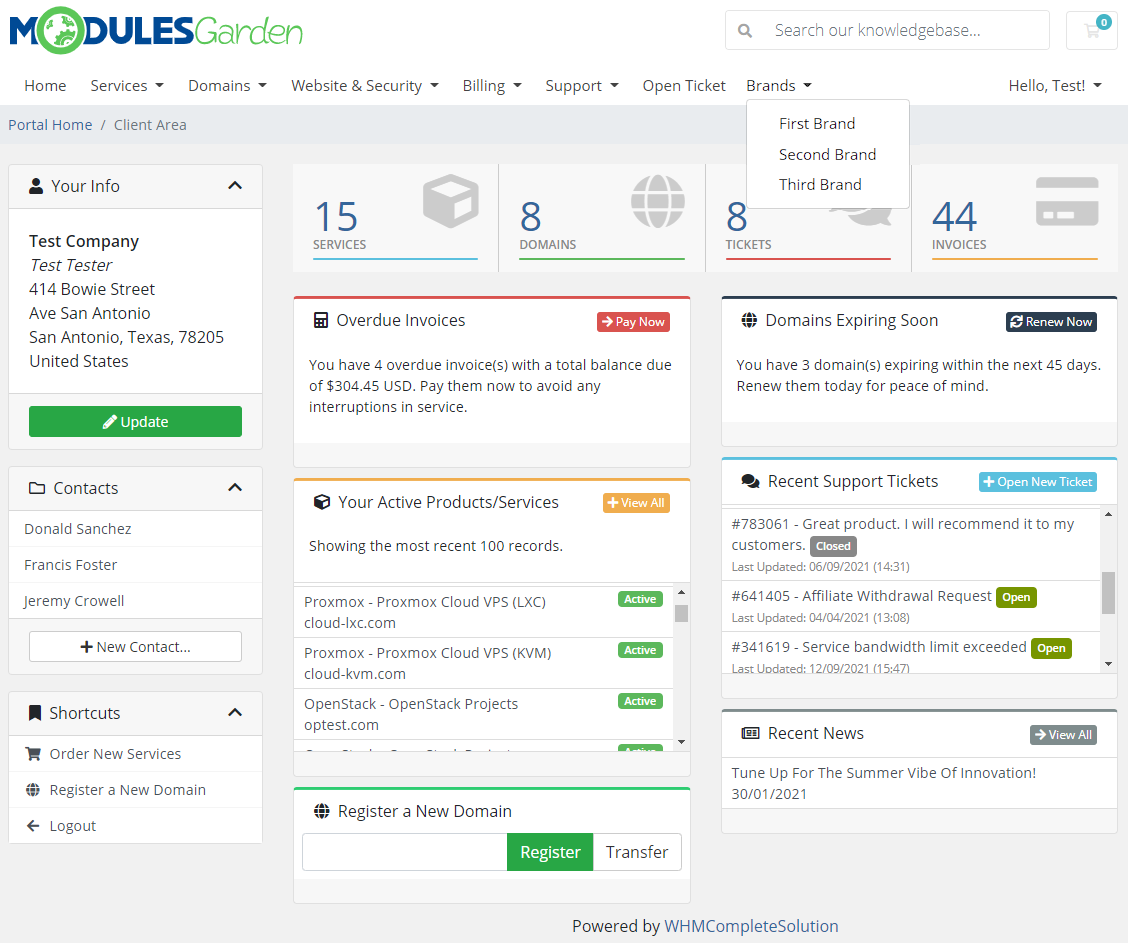
|
| On the following screen you can see invoices generated for a brand. |
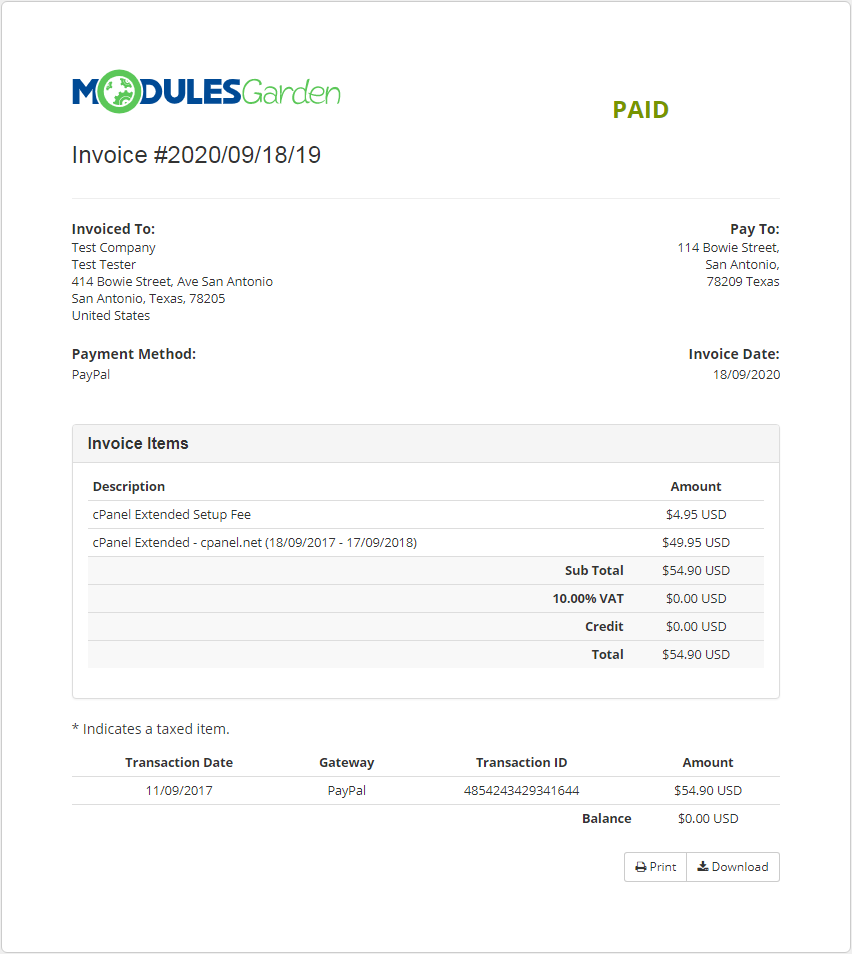
|
Branded Emails
| Brand configuration also apply to emails sent to clients. If you have enabled branding of a given template, the email sent to the client will be sent using the mailbox specified in the SMTP settings of the given brand. |
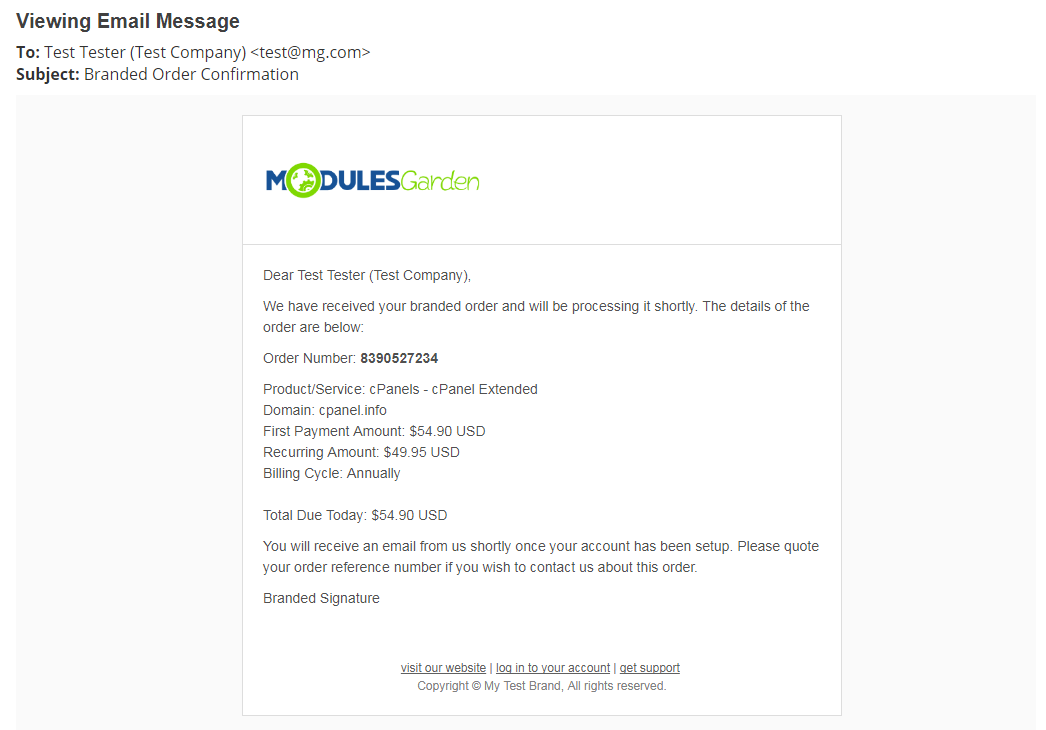
|
| More information you will find in branded Email Templates configuration. |
Domains & CNAME Records Configuration
| In this section you will find guides on how to create CNAME record in popular control panels. For instance, if your branded domain is 'reseller.com' and domain with your WHMCS is 'whmcs.domain.com' , your CNAME will be 'www.reseller.com. CNAME whmcs.domain.com.'. |
| Domain used by each of the brands must be parked on the main domain. In case a domain cannot be parked or it is a subdomain, you must create CNAME records that will redirect from the brand domain to the main domain. Only when you have parked your domains you can move to setting CNAME records on your panels. See the tips below. |
cPanel
| 1. Log into your cPanel. |
| 2. Press 'Simple DNS Zone Editor' under 'Domains' section. |
| 3. Select the domain you wish to manage from the menu. Note: This step is required only if you own more than one domain. |
| 4. Fill in 'Name' and 'CNAME' record and press 'Add CNAME Record'. Note: To define record's TTL, you have to use 'Advanced DNS Zone Editor'. |
DirectAdmin
| 1. Log into your DirectAdmin. |
| 2. Click 'DNS Administration' . |
| 3. Afterwards, press select the desired domain. |
| 4. Fill in the full domain/subdomain into the CNAME record and press 'Add' next to it. Note: Do not forget to place a dot at the end. |
Plesk
| 1. Log into your Plesk panel. |
| 2. Press 'Domains' under 'Hosting Services' section. |
| 3. Find the domain to be edited, and click on the corresponding Control Panel link. Afterwards, proceed to 'Websites & Domains' tab and press 'DNS Settings' . |
| 4. Find the domain to be edited, and click on the corresponding Control Panel link. Afterwards, proceed to 'Websites & Domains' tab and press 'DNS Settings'. |
| 5. Add a new record or edit an existing one. |
| 6. Now, change the record type to 'CNAME' and fill in both 'Domain name' and 'Canonical name'. Finish by pressing 'OK'. |
| Remember to restart your server once it is configured. |
SSL Certificate
| In this section you will find all information related to SSL certificate in WHMCS using Multibrand. If your branded domains or WHMCS domain are using SSL connection, all of them need to have the same certificate.
This is due the way in which WHMCS works. It is not the limitation of our module which is using 'WHMCS System URL' scheme. cPanel
Branding LimitationsBeta Version 2.0.0
WHMCS
WHMCS Modules and Others
Tips
Common Problems
|
